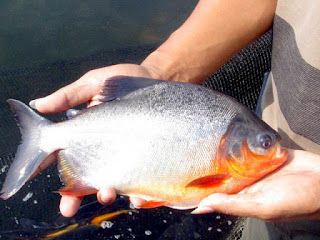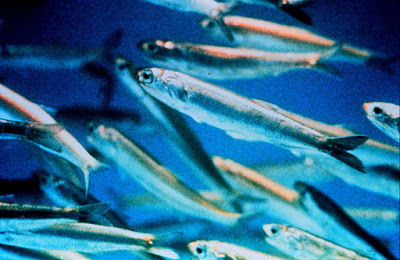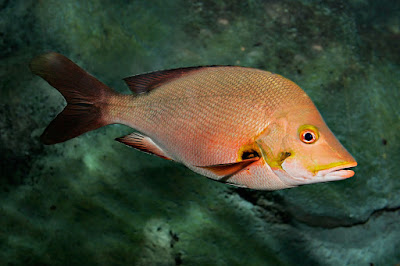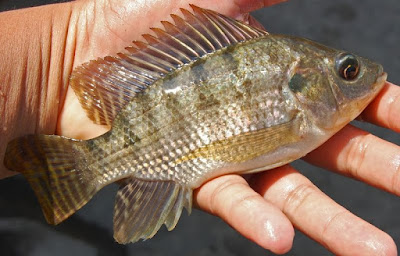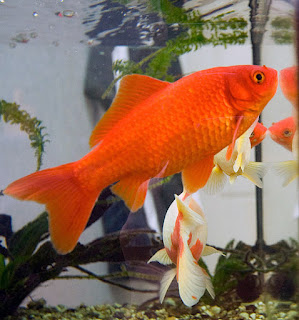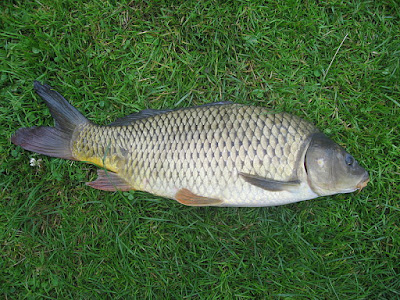Toman fish or known Mastacembelidae is a fish that lives in freshwater, fish species have ivertebrata glance similar to an eel but rear tilan fish has fins like spines lined and has a body that is slightly flattened. Fins that are behind the fish's body tilan serves to escape when he was hit by a fishing rod, his body will be rolled and swirled to decide on the fishing line for fins that are behind this fish is sharp enough time experience mancinya Berbedah with fish on this one, fish this does have the body shape and the same population with fish tilan above but this kind tilan fish have fins on the rear that is not berpungsi like tilan above, the fins are small and not sharp. In southern Sumatra Daera natural fences precisely in this fish is called
POMFRET
Fish Pomfret Pampus argenteus, often the primary choice of special meals at the bridal table or the main desk. In amnya fish Bawal terbahagi to two types namely white and black pomfret. White pomfret said higher demand versus the black pomfret.
Well known for its white pomfret pomfret call mirror, flash, white or dueh dueh flunky. He also called Silver Pomfret. Bawal mirror shaped like rombus and slightly convex. Bawal adult mirror looks wider and convex. Mata is located in the head portion continued verisimilitude continue with the agency.
Although the body Bawal invisible mirror her mouth and eyes wide but rather small and assembled at the corner of the tip portion of the head. Upper and lower jaws should also not be opened widely.
It may also pomfret mirror got its name from the reflection of light from his shiny and silver. Finish line in his senses stems from the gills to the tail mencecah zon.
When the pectoral fins are longer compared to the dorsal fin and tail curved shape of V. Colour - Body covered with fine scales pomfret mirror heave silver white and gray color exudes fin portion. Courant Sesetengah body covered with fine black spots.
Ikan Bawal numerous in Lautan Hindi besides Africa, Malaysia and Japan.
Bawal fish live and swim in berkumpulan. Usually in a particular season pomfret be found with a lot of mirrors. He is also said to be often found in tandem with shrimp on the seabed.
Pomfret species movement in the herd catches make it as convenient to use gillnets. However he may be arrested using hook and line and longline
Well known for its white pomfret pomfret call mirror, flash, white or dueh dueh flunky. He also called Silver Pomfret. Bawal mirror shaped like rombus and slightly convex. Bawal adult mirror looks wider and convex. Mata is located in the head portion continued verisimilitude continue with the agency.
Although the body Bawal invisible mirror her mouth and eyes wide but rather small and assembled at the corner of the tip portion of the head. Upper and lower jaws should also not be opened widely.
It may also pomfret mirror got its name from the reflection of light from his shiny and silver. Finish line in his senses stems from the gills to the tail mencecah zon.
When the pectoral fins are longer compared to the dorsal fin and tail curved shape of V. Colour - Body covered with fine scales pomfret mirror heave silver white and gray color exudes fin portion. Courant Sesetengah body covered with fine black spots.
Ikan Bawal numerous in Lautan Hindi besides Africa, Malaysia and Japan.
Bawal fish live and swim in berkumpulan. Usually in a particular season pomfret be found with a lot of mirrors. He is also said to be often found in tandem with shrimp on the seabed.
Pomfret species movement in the herd catches make it as convenient to use gillnets. However he may be arrested using hook and line and longline
ANCHOVY
anchovy or is a group of small marine fish, family members Engraulidae. This name covers a variety of fish with the body color silver greenish or bluish. And has a longitudinal line of the basic anatomy of the caudal fin
although there engraulidaei members that have a maximum length of 23 cm, anchovy name usually given to fish with a maximum length of 5 cm. Snout blunt with small, sharp teeth in both jaws. The main prey of anchovy is plankton and fish freshly hatched aja
they spread and can be found in several areas throughout the world's oceans, but are concentrated in temperate waters, and they are rare or absent in the water is very cold or very warm sea. They are generally very suitable (flexible) to a range of temperature and salinity. , Can also be found in shallow, brackish water, in estuaries and bays
anchovies are abundant in the Mediterranean region, and look also at the Sicilian coast, Italian, French, and Spanish. They are also found on the coast of North Africa. Various species also extends along the Atlantic coast of Europe to the south of Norway. Spawning Occurs between october and march, but not in water colder than 12 ° C (53.6 ° F). The proliferation occurs between the months of October and March, but not in cold water of 12 ° C (53.6 ° F). Anchovy spawn at least 100 kilometers (62 miles) from the coast, near the surface of the water
in Rome, anchovy serve as the manufacture of garum (fish sauce), which is an essential seasoning included in roman,
so also in malaysia with budu name, and also in Vietnam
in india: fresh anchovies are already salted fried or mixed in a spicy curry
in Singapore, Japan, Korea: anchovy made in a kind of soup
in Indonesia: macem "gan, in jadiin anchovy sauce, fried anchovies, anchovy fried rice, etc.
Anchovy Prevent Osteoporosis to prevent osteoporosis everyone needs as much as 1 gram of calcium per day.
Calcium needs can be obtained from fish that are common in Indonesia. Anchovy has been more consumption by the middle to bottom, it is one of the best sources of calcium to prevent bone loss.
"We do not need prestige, if that is the best source, why do not we eat,"
He also said, anchovy is a source of calcium that is resistant and not easily soluble in water.
However, because in our society have a presumption eat anchovies are those indicators that are not economically able, eventually many who ignore it.
In fact, fish is excellent as a source of calcium that is cheap and easily available, he said.
While Dr. Endang Darmoutomo MD MS, a nutritionist also of Siloam said,
the best of anchovy as a source of calcium is bone. So it was not just flesh.
Virtually all the fish could be a source of calcium, but because the bones in fish, other than anchovy, large and hard, it is not possible in consumption.
While on anchovy bones soft and good to eat.
Selection of the anchovy more because of cheap and easily obtainable. Because, actually milk and cheese are the best sources of calcium. However, to consume both types of these calcium sources are expensive and not everyone can get it.
Teri can dungarees memprkuat Teeth
SNAPPER
Snapper is a benthic marine fish that live in groups in the foundations of coral or coral reef. Possessed traits that round flat body with an elongated fin along the back. Type snapper are found in Indonesia is a type of red snapper several other types are also numerous in the encounter is yellow snapper, black snapper and others.
Gammon is a typical fauna Riau Islands province because the province is home to snapper and snapper fish themselves are often used as food ingredients typical of spicy acid
The red snapper generally inhabits areas reef waters to the tidal estuary, and even some species tend to dig into fresh waters. Type-sized red snapper generally form packs that are not so great and migratory to occupy the bottom waters deeper part than the kind of small-sized. Also usually red snapper caught at depths of between 40-50 meters with a base substrate little coral and 30-33 ppt salinity and temperatures between 5-32ºC.
That morphology, body shape elongated red snapper until slightly flattened. His mouth is situated at the head end (terminal), there are usually canines (canine) in the jaw. The edge of the operculum usually jagged and scales ctenoid. The front part of the head was scaly or on the front of the gill cover there are several rows of scales. Often there are spots or stains black (blotches). Single dorsal fin with a radius of 9-12 fingers hard and 9-17 fin fingers fins weak branching. The anal fin with three fins hard and 7-14 branched fin weak
PARROT FISH
Tilapia is a kind of freshwater fish consumption. This fish introduced from Africa, eastern Africa precisely, in 1969, and has now become a popular pet fish in freshwater ponds in Indonesia and pests in every river and lake Indonesia. The scientific name is Oreochromis niloticus. the medium-sized pet, the total length of the snout to the tip of the tail reaches about 30 cm and sometimes nothing more and nothing less than that. Dorsal fin (with 16-17 sharp spines and 11-15 soft radii thorns; and pinnae analyst anal fin with 3 spines and 8-11 fingers. Body colored black or gray, with some transverse dark bands (stripes) are increasingly blurred in adult fish. Striped tail erect, 7-12 pieces. Throat, pectoral, pelvic fins, tail fins and dorsal fin tip with red or reddish when berbiak.ada season on the line linea literalist truncus tool function is to balance the fish while swimming Tilapia are still small yet visible difference genitals. After his weight reached 50 grams, can know the difference between males and females. The difference between male and female fish can be seen in the genital hole and secondary sex characteristics. In male fish, in addition to the anus is a hole in the form of genital small bulge tapering as a spending urinary tract and sperm. Body of male fish are also darker in color, with a jaw bone extends to the rear to give a solid impression, while females usually on the big belly
FISH GOLD ORNAMENTS
Goldfish are freshwater fish from family Cyprinidae and order Cyprin
iformes.
This fish is one fish that was first successfully domesticated, nurtured and cultivated man. Now goldfish or sometimes referred to briefly as carp, ornamental fish is one of the most popular aquarium. Carassius auratus auratus varieties of domesticated and displays finned tail mutations body double and compressed round shape called a goldfish.
As one member of the carp family which also includes the koi carp and carp krusia, goldfish is a domesticated version of cultivation of fish species Carassius auratus originally not too colored natural habitat in eastern Asia. This fish was first domesticated in China more than a thousand years ago, and since then has developed several different races. Goldfish has a tremendous variation, such as differences in size, body shape, fin array, and color (various combinations of colors including white, yellow, orange, red, brown, and black).
In Indonesia the term "goldfish" also refers to the common goldfish or "carp, are relatives of fish that can be consumed as a food ingredient
iformes.
This fish is one fish that was first successfully domesticated, nurtured and cultivated man. Now goldfish or sometimes referred to briefly as carp, ornamental fish is one of the most popular aquarium. Carassius auratus auratus varieties of domesticated and displays finned tail mutations body double and compressed round shape called a goldfish.
As one member of the carp family which also includes the koi carp and carp krusia, goldfish is a domesticated version of cultivation of fish species Carassius auratus originally not too colored natural habitat in eastern Asia. This fish was first domesticated in China more than a thousand years ago, and since then has developed several different races. Goldfish has a tremendous variation, such as differences in size, body shape, fin array, and color (various combinations of colors including white, yellow, orange, red, brown, and black).
In Indonesia the term "goldfish" also refers to the common goldfish or "carp, are relatives of fish that can be consumed as a food ingredient
GOLDFISH
Goldfish or carp fish (Cyprinus carpio)
is a freshwater fish that have economic value is important and is widespread in Indonesia. In Indonesia, the carp began to be maintained around the 1920s. Carp found in Indonesia are carp brought from China, Europe, Taiwan and Japan. Besides "goldfish Punten" and "carp Majalaya" is the result of selection in Indonesia. Until now there are 10 carp which can be identified by morphological characteristics According to Djoko Suseno (2000), Indonesia's first carp came from mainland Europe and China which later evolved into fish cultivation are very important. Meanwhile, according to R.O Ardiwinata (1981), carp were grown in Indonesia allegedly originally came from southern China. Mentioned, the cultivation of carp known to have grown in the area Ciamis West Java in the mid-19th century. Local communities mentioned already using kakaban - Substrate for sticking carp eggs made from fibers - in 1860, so that the cultivation of carp in the pond in Galuh concluded already developed decades earlier. While the spread of carp in other regions of Java, noted occurred at the beginning of the 20th century, particularly after the form "Inland Fisheries Bureau" of the "Ministry of Agriculture" (Prosperity) at that time. From Java, carp then developed to Bukittinggi (West Sumatra) in 1892. Next was developed in Tondano (Minahasa, North Sulawesi) 1895, South Bali area (Tabanan) 1903, Ende (Flores, NTT) in 1932 and South Sulawesi year 1935. in addition, in 1927 at the request of the Bureau of Inland Fisheries when it also brings the kinds of carp from the Netherlands, which is the type of Galician ( "cARP elephant") and then in 1930 brought more carp species Frankisia ( "mirror carp") , According to Djoko Suseno (2000), both types of carp are highly favored by farmers because the meat tastes more savory, dense, prickly little and it grows faster than local races that have been developed in Indonesia before. In 1974, as proposed Djoko Suseno (2000), Indonesia imported Taiwan carp race, the German race and race fancy carp each from Taiwan, Germany and Japan. Around 1977, Indonesia imported "carp Yamato race" and "racial koi" from Japan. Those races are carp were imported in the development, in fact difficult to maintain its purity as the races mingle with carp that already exist in Indonesia before causing a cross and formed new races
is a freshwater fish that have economic value is important and is widespread in Indonesia. In Indonesia, the carp began to be maintained around the 1920s. Carp found in Indonesia are carp brought from China, Europe, Taiwan and Japan. Besides "goldfish Punten" and "carp Majalaya" is the result of selection in Indonesia. Until now there are 10 carp which can be identified by morphological characteristics According to Djoko Suseno (2000), Indonesia's first carp came from mainland Europe and China which later evolved into fish cultivation are very important. Meanwhile, according to R.O Ardiwinata (1981), carp were grown in Indonesia allegedly originally came from southern China. Mentioned, the cultivation of carp known to have grown in the area Ciamis West Java in the mid-19th century. Local communities mentioned already using kakaban - Substrate for sticking carp eggs made from fibers - in 1860, so that the cultivation of carp in the pond in Galuh concluded already developed decades earlier. While the spread of carp in other regions of Java, noted occurred at the beginning of the 20th century, particularly after the form "Inland Fisheries Bureau" of the "Ministry of Agriculture" (Prosperity) at that time. From Java, carp then developed to Bukittinggi (West Sumatra) in 1892. Next was developed in Tondano (Minahasa, North Sulawesi) 1895, South Bali area (Tabanan) 1903, Ende (Flores, NTT) in 1932 and South Sulawesi year 1935. in addition, in 1927 at the request of the Bureau of Inland Fisheries when it also brings the kinds of carp from the Netherlands, which is the type of Galician ( "cARP elephant") and then in 1930 brought more carp species Frankisia ( "mirror carp") , According to Djoko Suseno (2000), both types of carp are highly favored by farmers because the meat tastes more savory, dense, prickly little and it grows faster than local races that have been developed in Indonesia before. In 1974, as proposed Djoko Suseno (2000), Indonesia imported Taiwan carp race, the German race and race fancy carp each from Taiwan, Germany and Japan. Around 1977, Indonesia imported "carp Yamato race" and "racial koi" from Japan. Those races are carp were imported in the development, in fact difficult to maintain its purity as the races mingle with carp that already exist in Indonesia before causing a cross and formed new races
Langganan:
Komentar (Atom)

